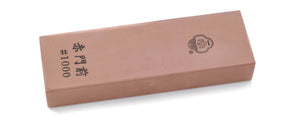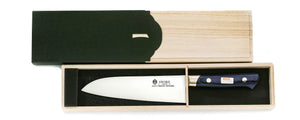Knife Making Regions of Japan
Many of the towns that have made a name for themselves as production areas for Japanese swords have passed on their techniques to the present day as production areas for kitchen knives and forged knives. Let's discuss each region and it's influence on Japanese Knives and Knife Culture.
Knife Manufacturing Regions
Most of the cities and regions of Japan that make Japanese Knives today, have their roots in hundreds of years of swordmaking tradition. Each region is unique and offers their own distinct influence on knives.
Before we get into each region, let's briefly answer a few common questions:
1. If the knife is made in one of these production areas, does that guarantee quality?
In short, these production areas incorporate many smaller companies working in a similar industry. We can't comment on the quality of every single producer, but we can say that there are many well regarded and respected knife makers, polishers, fitters and so on in those regions.
At Sakai Ichimonji we use a select few craftsmen and companies for our product, and we do not restrict ourselves to one region. What is more important than the region of manufacture, is the craftsman and materials involved.
2. Are all the knives really made in (Japan, Sakai, Seki etc.?)
Many knife making cities hold festivals and also have multiple stores where they sell products at extemely low prices. In some cases, these knives have been made in other areas of Japan, or even made overseas and shipped back to Japan where only the final finishing has been completed, and the final stamp of Made in "Region here" has been inscribed. This is why we think it's less important to think about which region the knife is made in, and more important to understand the manufacturing process and quality control behind each product.
3. Brand Name and Origin
There are many brands that include the name of the manufacturing region in their name. Even Sakai Ichimonji, denotes production in Sakai. But it is rare for any Japanese Knife Manufacturer to make products solely in one region. At Sakai Ichimonji the majority of our knives are indeed made in Sakai, Osaka. However, we do have a select few knives that are made in other regions of Japan. This can be for various reasons, such as access to a particular material or experience with a particular material.
All Sakai Ichimonji and Kirameki Knives are made in Japan and we do not outsource any production of our knives overseas.
4. Issues facing the industry
- Demand: As Japanese knives have become more popular overseas and exports increase, it has become harder for Japanese knife makers to meet this demand.
- Successors: The number of Japanese Knife Makers continues to dwindle as fewer young people enter the industry. The life of an apprentice knifemaker is harsh, exhausting and financially difficult. Many local governments are trying to lure new apprentices to these regions to train under the current generation, but still the pool of craftsmen continues to shrink.
Japanese kitchen knife production area
There are 6 major knife production areas in Japan.
Sakai City (Osaka Prefecture)
Sakai boasts an overwhelming share of the Japanese Knife market. In Sakai the handle fitting, blacksmithing and sharpening/polishing is divided amongst many craftsmen, where each is encouraged to improve their skills.
Seki City (Gifu Prefecture)
Seki City holds the largest share of domestic production in not just kitchen knives but also razors, scissors and other bladed tools. While highly efficient production by machine is used for the initial shaping and quenching of knives, sharpening, handle fitting and final finishing are done by hand. Seki is most known for producing western style knives.
Tsubame/Sanjo (Niigata Prefecture)
In fact, as shown on the map, Tsubame and Sanjo have the same roots, and the regions are often mentioned together, but the character of their kitchen knives is quite different.
Tsubame is famous for sophisticated kitchen knives with stainless steel handles, such as Tojiro, GLOBAL, and Kataoka Seisakusho, coupled with silverware and polishing techniques.
On the other hand, Sanjo's kitchen knives, such as Tadafusa and Hinoura Knife Studio, which have inherited the roots of Japanese nails, have the charm of quality and sturdiness that only handmade knives can offer.
Takefu (Fukui Prefecture)
It dates back to the Nanbokucho period (1336-1644), when a Kyoto swordsmith, Chiyotsuru Kuniyasu, moved to this area. Originally, the sickles that Kuniyasu made for local farmers while he was working on his sword were well received and developed. Some manufacturers still make kitchen knives alongside high-quality sickles.
In modern times, Takefu Knife Village and other overseas operations are very active, and young craftsmen are creating numerous innovative and stylish kitchen knives.
Takefu is also the home of Takefu Special Steel, a steel manufacturer, which is actively developing new blade steels and conducting technical research with local craftsmen, which has also contributed to the development of the knife industry in this region.
Tosa (Kochi Prefecture)
It developed around the end of the 16th century when Motochika Nagasogabe allowed sword smiths to live in the area.
The town is steeped in the spirit of wild blacksmithing, as typified by rough blacksmithing and free forging.
There has been a long history of technical exchange with Sakai, producing inexpensive yet high quality Japanese knives.
While maintaining affordability, the town has produced many craftsmen and manufacturers as one of the leading cutlery production centers in Japan.
In recent years, the local government and companies have worked together to foster young craftsmen, including the founding of the Blacksmith Creation School.
Miki (Hyogo Prefecture)
The history of cutlery in Miki is long, and since ancient times, the area has been associated with the god of forging, Tenmoku Ikkoku-no-Mikoto, and Yamato forging flourished in the area.
In the 5th century, Korean blacksmiths came to Miki from Baekje and developed Miki's blacksmithing techniques. At the end of the 16th century, carpenters gathered in Miki to rebuild after the war, and Miki became the origin of the carpentry tool production area.
Higo-mori, a small sword that was said to have been in every child's pencil box until around the postwar period, is now made only in Miki.
High-grade razors are very popular among foreigners (many people have relatively thick beards and prefer hand-forged razors with a sharp edge) and wood planers, an important tool of carpentry, are often made in Miki.
Structure of knives that each region is good at
The chart below gives a basic breakdown of the merits of each knifemaking region. These are general and of course there are many exceptions to the rule.
| Shape | Manufactering Method | Main Region | Description | Merit | Demerit |
| | Full Steel | Seki City (Gifu Prefecture) | The entire blade is made of one piece of steel. | The cutting edge can be sharpened to any desired shape. Because it is comprised of a single layer of steel, it has a firm cutting performance. | Chips can become larger. |
| | Dual Composite | Seki City (Gifu Prefecture) | Cutting edge steel is surrounded by soft iron on the sides. | Relatively inexpensive | Short life |
| | Clad | Takefu City (Fukui Prefecture) Seki City (Gifu Prefecture) Tsubame City (Niigata Prefecture) | The steel material itself is composed of layers of 2 kinds of steel: the outside steel and the core (cutting edge) steel. | Can add the other techniques such as Damascus and Tsuchime. Cracks and rust are relatively easy to stop. Easy to check the cutting edge when sharpening. | Difficult to increase the strength of the cutting edge. Unable to sharpen to be a single edge. |
| | Double Edge Forging | Sakai City (Osaka Prefecture) Sanjo City (Niigata Prefecture) | Hammering the layers of the outside steel and core (cutting edge) steel to be thin. | The blade is stronger than cladding. | Strength and sharpness are greatly influenced by craftsmen. Mass production is not possible because it is handmade. |
| | Single Edge Forging | Sakai City (Osaka Prefecture) Tosa City (Kochi Prefecture) | Forge welding of the cutting edge steel and the outside steel (only one side). | Sharp and tough | Prone to chipping, so need to handle carefully. |
| | Single Edge Honyaki | Sakai City (Osaka Prefecture) | Forged blade which is made of one piece of steel. The spine's side is quenched to resist fracture. | The cutting edge is sharp and has a firm cutting perfomance. | High risk of chipping and cracking. Expensive because only a few skilled craftsmen can make it. |































